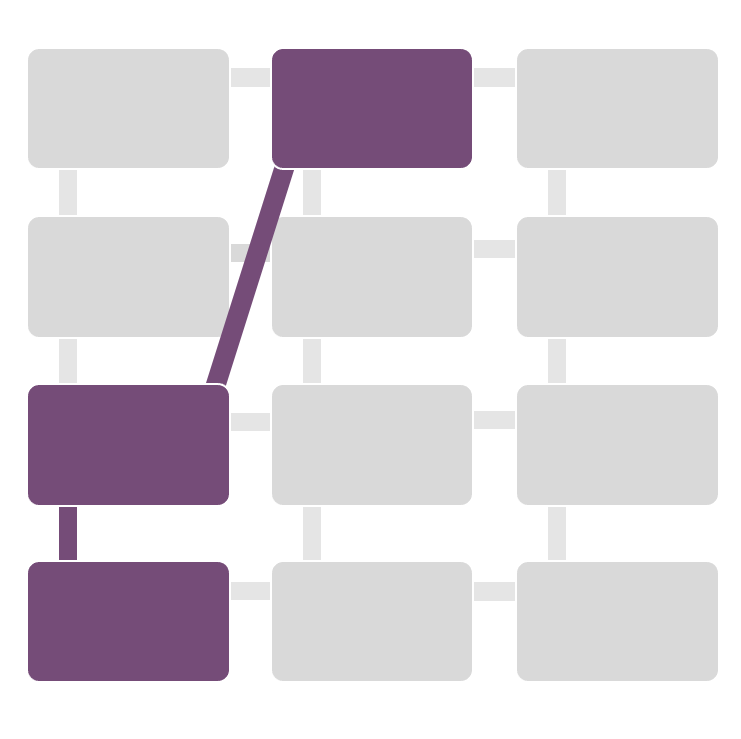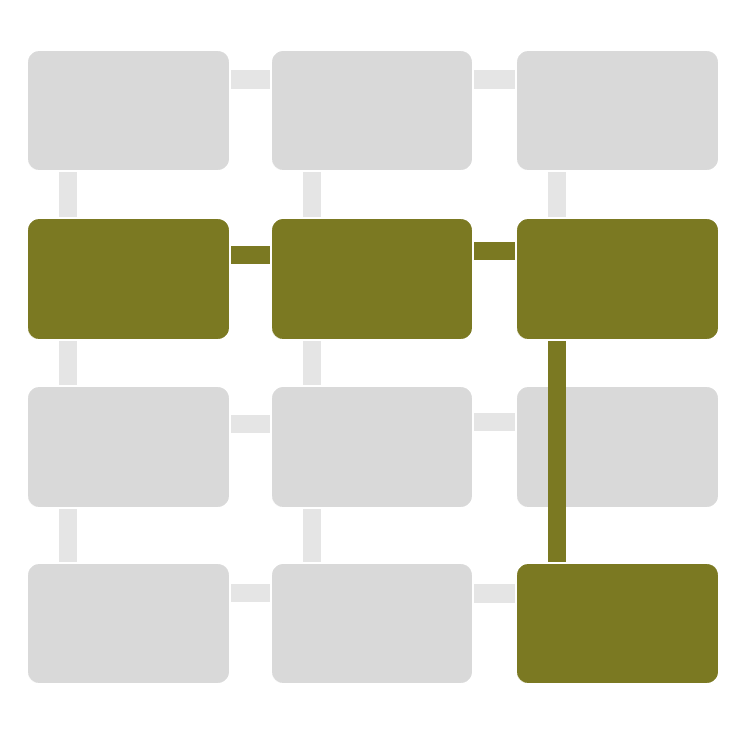Table of Contents
Radiant Figures offers seven distinct hypertextualized polyvocal paths. Each chapter is featured in at least two paths, emphasizing the complex, overlapping nature of performing vizadmin work for multiple purposes across myriad institutional contexts.
Each path also features a response from an experienced administrator-scholar in rhetoric and writing studies, which draws connections, highlights promising questions, and speculates about possibilities for uptake and adaptation of the vizadmin work described in the path.
Each path is briefly described below, with access to responses and individual chapters:

- Mapping in/as Administration—Louise Wetherbee Phelps, respondent
As a field, we have relied on mapping and its intellectual history to re-think, re-see, and re-envision complex systems and sites. Chapters in this path explore how both new and experienced WPAs use mapping to visualize and circulate program histories and values.
- 04. "WPA Responsive Genre Change: Using Holographic Thinking to Unflatten a Celebration of Student Writing," by Kate Pantelides, Jacie Castle, and Katherine Thach Musick
- 05. "Diagram as Boundary Object: Incorporating Visuals Into WPA Practice," by David S. Martins
- 09. "Networks of Discourse: Using Network Mapping to Examine the Influence of Institutional Histories and Program Missions on Students’ Writing Development," by Jacob W. Craig and Chris Warnick
- Visualizing Complexity and Simplicity—Diana George, respondent
WPAs often turn to visualization as a generative means of showing great program complexity and of introducing inventive simplicity. Chapters in this path illustrate issues of legibility and uptake when WPAs visualize complexity, attempt simplicity, or toggle between the two.
- 01. "Thinking Through Data Visualization: Leveraging the Exploratory Power of Figures to Create WPA Knowledge," by Julia Voss and Heather Turner
- 03. "Visualizing the Role of Small, Stubborn Facts: Changing Stories of Writers and Writing," by Ryan J. Dippre
- 07. "Is Teaching Just a List? Toward Feminist-Humanistic Visual Representations of Being a Writing Teacher," by Rachel Gramer
- 08. "An Ecological Heuristic for Programmatic Curricular Revision and Transformation," by Natalie Szymanski
- 09. "Networks of Discourse: Using Network Mapping to Examine the Influence of Institutional Histories and Program Missions on Students’ Writing Development," by Jacob W. Craig and Chris Warnick
- 10. "Visualizing Fairness: A Critique and Revision of Placement Practices for International ESL Students," by Jamie White-Farnham
- Visualizing Change—Kathleen Blake Yancey, respondent
Graphics have the power not just to represent change, but to enact change both in and over time. Chapters in this path show how graphics participate in pedagogical innovation, curricular development, and programmatic change.
- 03. "Visualizing the Role of Small, Stubborn Facts: Changing Stories of Writers and Writing," by Ryan J. Dippre
- 05. "Diagram as Boundary Object: Incorporating Visuals into WPA Pedagogical Practice," by David S. Martins
- 06. "Designing to See, Mean, and Act: Giving Shapes to Programmatic Goals,” by Laurence José
- 11. "Maps, Stamps, and Plans: Using Visual Interactive Course Documents to Promote Student Autonomy and Engagement," by Andrew Lucchesi
- 12. "Graphic Re-Imaginings: Curricular Revision With/in/Through Programmatic Representations," by Logan Bearden
- Visualizing Program Data—Amy Ferdinandt Stolley, respondent
How WPAs visually (re)present crucial programmatic data can improve the lived experiences of students and instructors. Chapters in this path demonstrate different means of visualizing data and articulate their visual literacy requirements, affordances, and implications.
- 01. "Thinking Through Data Visualization: Leveraging the Exploratory Power of Figures to Create WPA Knowledge," by Julia Voss and Heather Turner
- 02. "Silhouette of DFWI: Census Pictographs as Social Justice Heuristic," by Derek Mueller
- 09. "Networks of Discourse: Using Network Mapping to Examine the Influence of Institutional Histories and Program Missions on Students’ Writing Development," by Jacob W. Craig and Chris Warnick
- Visualizing Inventive Play—Jason Palmeri, respondent
Working with visuals can be generative, inventive, and even playful for writing teachers and administrators. Chapters in this path showcase the different insights and strategies that image work can reveal to students, to ourselves as WPAs, and to audiences within and beyond our programs.
- 02. "Silhouette of DFWI: Census Pictographs as Social Justice Heuristic," by Derek Mueller
- 04. "WPA Responsive Genre Change: Using Holographic Thinking to Unflatten a Celebration of Student Writing," by Kate Pantelides, Jacie Castle, and Katherine Thach Musick
- 08. "An Ecological Heuristic for Programmatic Curricular Revision and Transformation," by Natalie Szymanski
- 11. "Maps, Stamps, and Plans: Using Visual, Interactive Course Documents to Promote Student Autonomy and Engagement," by Andrew Lucchesi
- 12. "Graphic Re-Imaginings: Curricular Revision With/in/Through Programmatic Representations," by Logan Bearden
- Visualizing Advocacy—Heidi Estrem, respondent
WPAs create and employ graphics to advocate on behalf of students in our programs and elsewhere on campus. Chapters in this path illustrate the ability of graphics to work toward more equitable academic practices for undergraduate and graduate student populations.
- 02. "Silhouette of DFWI: Census Pictographs as Social Justice Heuristic," by Derek Mueller
- 07. "Is Teaching Just a List? Toward Feminist-Humanistic Visual Representations of Being a Writing Teacher," by Rachel Gramer
- 10. "Visualizing Fairness: A Critique and Revision of Placement Practices for International ESL Students," by Jamie White-Farnham
- Program Visibility—Annette Vee, respondent
Effective program leadership often involves increasing program visibility using all available communicative resources. Chapters in this path explore the utility in and possibilities of using graphics to represent program values, events, and curricula to audiences within and beyond our programs.
- 04. "WPA Responsive Genre Change: Using Holographic Thinking to Unflatten a Celebration of Student Writing," by Kate Pantelides, Jacie Castle, and Katherine Thach Musick
- 05. "Diagram as Boundary Object: Incorporating Visuals Into WPA Practice," by David S. Martins
- 06. "Designing to See, Mean, and Act: Giving Shapes to Programmatic Goals," by Laurence José
- 12. "Graphic Re-Imaginings: Curricular Revision With/in/Through Programmatic Representations," by Logan Bearden
- 00.01 Types of figures found in WPA scholarship sample
- 01.01 Mock alluvial diagram
- 01.02 Sample alluvial diagram
- 01.03 Alluvial diagram for course scheduling
- 01.04 Alluvial diagram for classroom types
- 02.01 Census pictograph based on grade distribution
- 02.02 Census pictograph based on grade distribution
- 02.03 Census pictograph with graphemic qualities added
- 02.04 Census pictograph heuristic
- 02.05 Census pictograph refigured
- 03.01 The role of small, stubborn facts
- 04.01 Celebration of student writing map
- 04.02 Unflattened map (interactive; external link)
- 04.03 Revised 2D celebration of student writing map
- 04.04 Photograph of 3D diorama
- 05.01 Current model for writing at RIT
- 05.02 A model for enhancing student writing at RIT
- 06.01 Digital studies minor program card/flier (front)
- 06.02 Digital studies minor program card/flier (back)
- 06.03 Promotional table-top banner
- 07.01 Types of figures found in WPA scholarship sample
- 07.02 Haswell's table of the work of a writing teacher
- 07.03 Infographic created for first-year writing graduate student instructors
- 08.01-08 Writing program administration as an ecological heuristic
- 09.01 Complete network map in organic layout
- 09.02 Nodes in the map related to Bridge program
- 09.03 Nodes in the map related to pedagogical focus of FYW course
- 09.04 Example set of interconnected nodes
- 09.05 One possible reconfiguration of the network map
- 09.06 A second possible reconfiguration of the network map
- 09.07 The network map annotated
- 09.08 Cluster of nodes focused on mission and goals of Bridge program
- 09.09 Cluster of nodes indicating relationships
- 10.01 Decision tree illustrating placement
- 11.01 Playable syllabus
- 11.02 Playable syllabus in its first iteration, Spring 2017
- 11.03 Prototype of revised playable syllabus game board
- 12.01 Current outcomes graphic
- 12.02 Revised outcomes graphic using Beaufort's knowledge domains as a model
- 12.03 Spiral curriculum example
- R01.01 Pattern of program development
- R01.02 Participants and roles
- R01.03 Writing program collaborative organizational chart
- R01.04 "Publishing" as a function of learning, teaching, and researching in the academic community
- R01.05 Writing program curriculum (tree)
- R01.06 Writing program curriculum (braid)
- R01.07 Studio 'basics'
- R01.08 Leadership nexuses
- R01.09 Intersecting variables of rhetorical location in academic leadership
- R01.10 Mapping faculty activity onto the grid
- R01.11 Administration as a design art
- R01.12 Bad fit
- R02.01 Writing center use by year
- R02.02 Writing center use by college
- R02.03 Writing center use by classification
- R03.01 Example of London tube map
- R03.02 Additional example of London tube map
- R03.03 Sample “course on a page” document
- R03.04 Map of tectonic plates
- R03.05 Graphic detailing possible locations of student writing
- R03.06 Another example of locations of student writing
- R03.07 Image representing revisions to the WPA GO logo
- R04.01 Image from Unflattening
- R05.01 Spiral curriculum example
- R05.02 Writing program administration as an ecological heuristic
- R05.02 Writing program administration as an ecological heuristic
- R05.03-04 Photographs of individual and collective urban composting bins
- R07.01 A hand illustrated map of program visibility





